On may 18th 2019, I participated in a conference in Nantes, France, where I’ve been talking about the difference between what is summarized as Animation in France, and Motion Design.
To prepare this presentation, I had to know a little bit more about what makes them two different fields. I also wanted to work with actual numbers, as accurate as possible, so I’ve begun by posting a short survey on social networks, to build some kind of study on the subject.
Here are my results, which I’m going to try to keep up-to-date, as it’s an interesting glimpse at these industries.
To make these numbers representative, we need as many answers as possible from people working either in the animation (fiction) industry and the motion design industry. If you’d like to be part of the survey, you just have to fill out this form, it will just take a few minutes – the form is available both in English and French. Please do it before you read these results so you’re not influenced by them.
Animation & Motion design: a moving boundary
Let’s try to figure out the definition of Animation and of Motion design.
Classification
First, one has to keep in mind that like most of attempts to classify things, put them in small boxes, there always will be some exceptions, some other ways to sort them, and a more or less important part of subjectivity. Definitions and classification can also vary a lot with time and depending on the era ; just have a look at how living organisms are classified and have been classified accross time. Do you think it’s obvious that there are animals and plants and they are completely different things? Then try to apply your definitions to micro-organisms, corals, mushrooms, etc.
What we’re trying to do is to classify things in a way to make them easier to understand in most cases, if not all. This also means that a classification may change depending on what we’re trying to talk about, to analyze.
Some definitions
When asked what motion design is, people often think about what makes it formaly different than animation: very often, there’s typography, abstract shapes, etc.
Having given this a lot of thought, and discussed the subject with many motion designers and animators, I’ve come to realize that this formal difference is more a consequence than the actual difference between Animation and Motion Design.
A useful way to define them is to have a look at their goal as a product. Here are the definitions I’m using in this article.
- Motion Design is the production of animated graphics (including characters) with the goal of serving something else, which carries a specific information which the audience has to understand. It has a specific goal which is not (only) entertainment: give some information, sell a product, explain a concept…
It includes explainers, data visualization, advertising, opening and ending credits in movies… - Animation (or animated fiction) is the production of animated graphics which are self-suficient and are not linked in any way to other work. It is mainly fiction, artworks or documentaries, which main goal is to entertain or make the audience react.
It includes short movies, feature films, tv shows…
These definitions help classify a large part of animated movies ; of course some of them could still be in between, and I think another specific category should be added to these two: animated music videos, which could be considered as works made to promote the music, or as artworks on their own.
What makes these definitions pertinent, is that they explain the formal difference between what I’m going to call animated fiction and motion design.
One of the most famous cartoon transformed into a kind of self-suficient artwork. Clearly classified into the Animation cateogry.
Saul Bass is considered as one of the pioneers of Motion Design, with his highly stylized opening credits for famous movies.
As Motion Design works are made to explain, sell, transmit another product or information, they are mainly paid by the owner of the involved product. They are made on request by a client. The consequence is that the budget is generally lower than in fiction productions, the production time is usually much shorter, and the client validates the production.
On the contrary, fiction productions have longer time and higher budgets, and in some areas in the world can benefit from public funds, mainly based on the artistic quality of the projects. The validation is made by the director and the producers.
Of course this could be discussed, as in fiction there are clients too (TV channels, distributors and theaters…) but usually they do not have as much impact on the final work than other clients.
These difference explain why animated fiction may be so different than motion design, visually speaking. Let’s have a closer look at what makes them different from the inside, about how they’re produced.
In another article, I’ll have a look at how each industry influences the other, how motion design techniques can be found in animated fictions, and how the motion design industry can be inspired by animated fiction.
A humble study
In order to precisely analyze the differences between the motion design and the animated fiction industries, I’m asking a few questions to people working in these industries. You can have a look at the questions and join the survey here.
Click here to download the raw data from the study (LibreOffice *.ods).
Biases
So far, these results are based on 105 cases both from the motion design industry and the animation industry. More contributions would make the results more precise and representative, but some tendencies are already neats.
It is to be noted that there have been a lot less answers from people in the animated fiction industry, so specific results about this field are less precise than in the motion design industry.
As I am the developper of Duik, a character rigging and animation toolset, and as I am the original poster of the survey used in this study, the results are biased because of the community reached, which is mostly made of users of Duik. This is especially true for the statistics about the use of software and rigging tools. That said, I’m pretty confident that the numbers are accurate for the motion design industry, and could be with more contributions from the animation field.
The numbers have been rounded for the sake of clarity and to keep them right without having to update the article too often.
Team size
If we have a look at the usual sizes of the teams in the Animation or Motion Design industry, it’s clear that the two fields have very different kinds of productions.
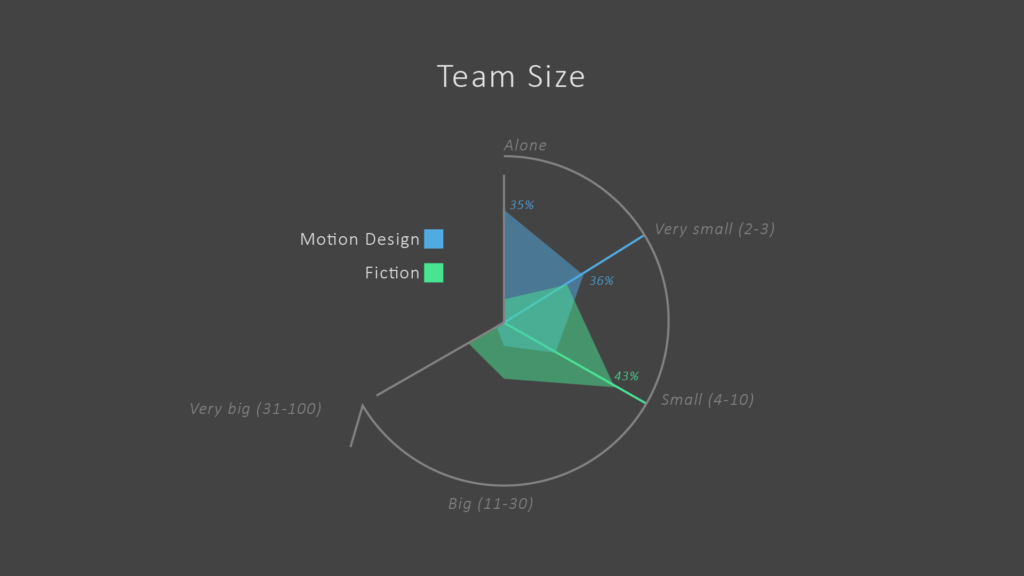
- Motion Design: more than 70% of the motion designers work in teams smaller than 3 people.
- Fiction: about 75% work in teams bigger than 4 people, including 30% of them working in teams bigger than 11 people.
This difference is surely the direct consequence of the difference between the budgets of the productions, but it is also probably the consequence of the time taken to produce a single movie. As in the motion design industry productions usually last a shorter time, there’s no time to build and train large teams on specific projects. As we’ll see later, this may explain why the techniques and softwares used in the motion industry vary less than in fiction.
Specialization
As the organization of the productions are so different between fiction and motion design, and because of the difference of the size of the teams, we can expect that the level of specialization is also different.
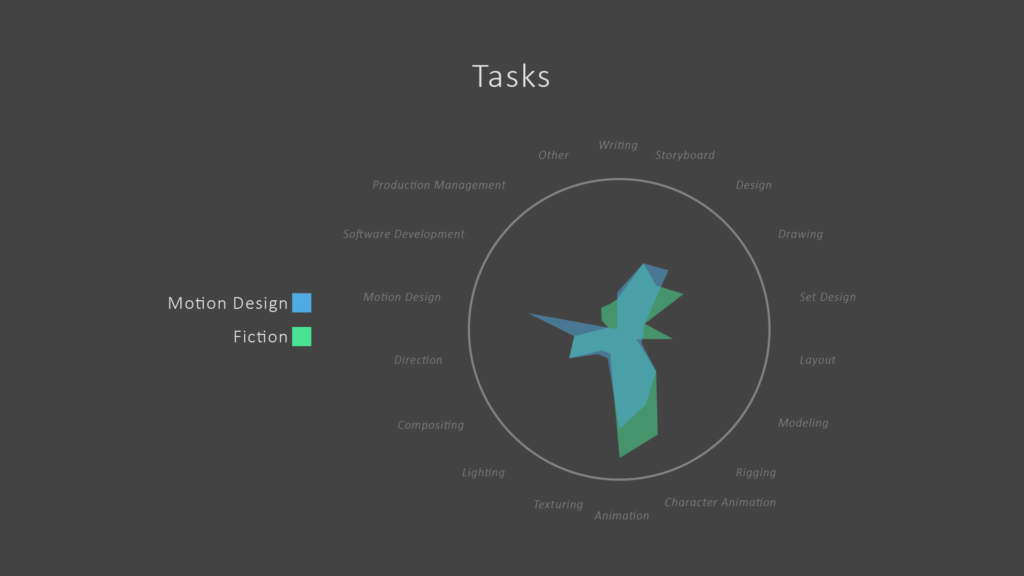
If we compare the different tasks involved in the two industries, without surprise motion design involves proportionnaly more work with “pure” motion design (12% vs 2%). As expected, there’s more work for general animation and character animation in the fiction industry (15% for fiction, 11% for motion design) , but there are also smaller differences which can be noticed.
1.16% of the work in fiction consists in software development (only 0.36% in the motion design field). The layout step is also very minor in motion design (3%) whereas in fiction it’s an important task (7%).
With this list, we can compare how many different tasks per person are usually done for each field. It’s an effective way to evaluate the level of specialization of people working in the two industries.

- Motion Design: 84% have more than 4 different tasks in their work (the median is 7 different tasks).
- Fiction: 78% have less than 4 different tasks in their work (the median is 3 different tasks).
When asked directly if they’re generalists, generalists with a few preferred fields, specialists with more than one specialty or experts in one specific task, people’s answers also help to figure out the level of specialization for each industry.
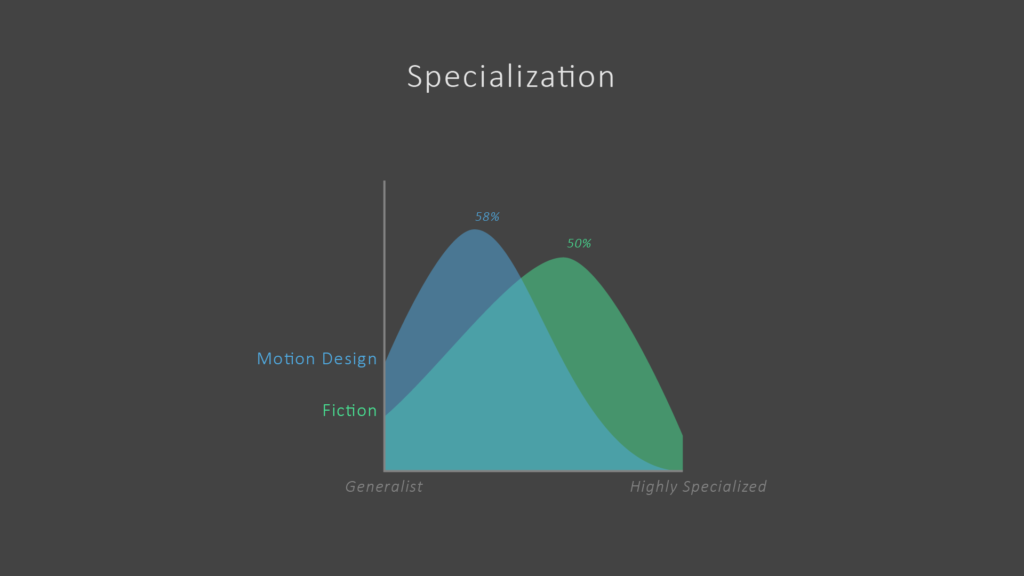
- Motion Design: 84% consider themselves generalists
- Fiction: 55% consider themselves specialists or experts
These two ways of evaluating the level of specialization both shows that working in these industries is a specialized work, but also that in the fiction industry, people are even more specialized, a non negligible part of them even being experts in a specific task.
As teams are bigger in the animated fiction industry, work has to be more organized and divided between workers who tend to specialize more. This also explains why the part of production management in this industry is a bit higher than in the motion design industry.
Animated Characters
It appears that one of the noticeable difference between fiction and motion design is the quantity of projects which include character animation.
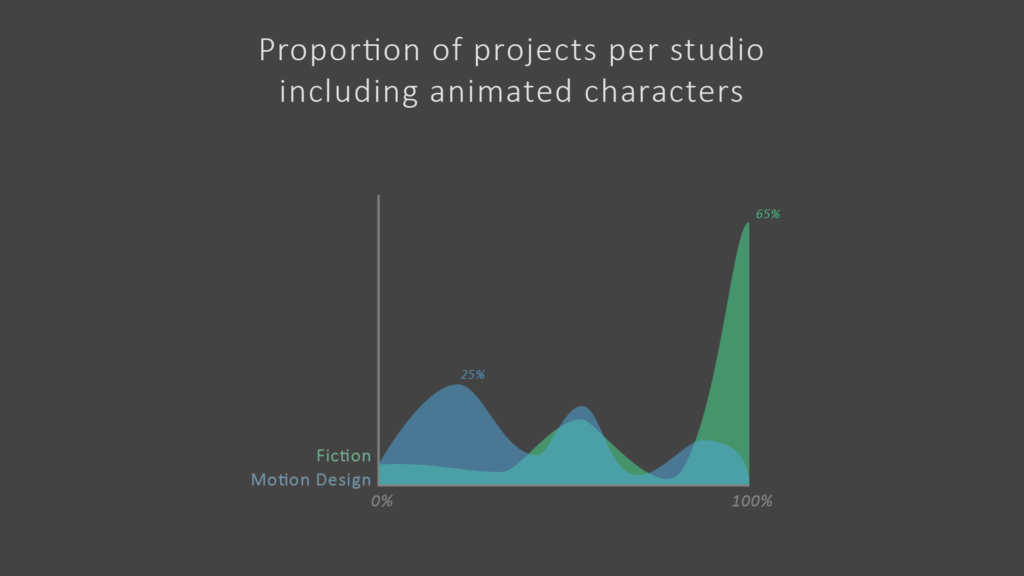
- Motion Design: 36% of the projects include character animation. The average studio include animated characters in 30% of its projects.
- Fiction: 77% of the films include character animation, and a vast majority of studios (65%) of them include animated characters in more than 90% of their productions.
In the motion design industry, depending on the studios, the proportion of projects which include animated characters can vary a lot (between none and more than 90%) but on average studios include animated characters in 30% of their projects, whereas in the animation industry, most of the studios produce more than 90% of their films with character animation.
This may seem obvious, but it has evolved a lot during the 2010’s, and the number of studios doing character animation in the motion design industry has been growing a lot, with a peak in 2015.
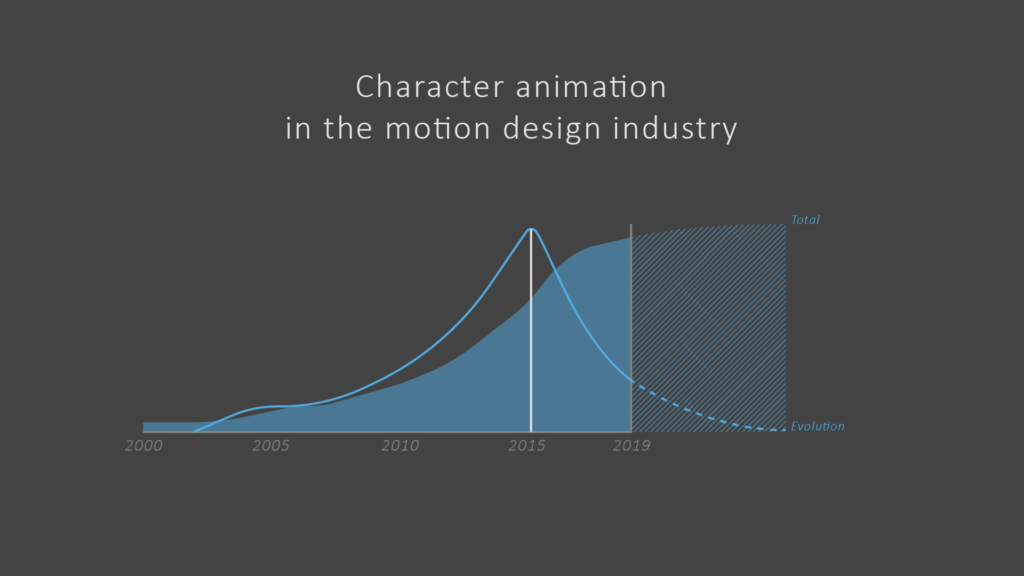
Since 2015, the number of new motion design studios using animated characters tends to decrease. This may be the sign that almost all of them have begun using them. In a next study, it would be interesting to have a look at the progression of the number of projects including character animation and not only on a per studio basis.
Technique and software
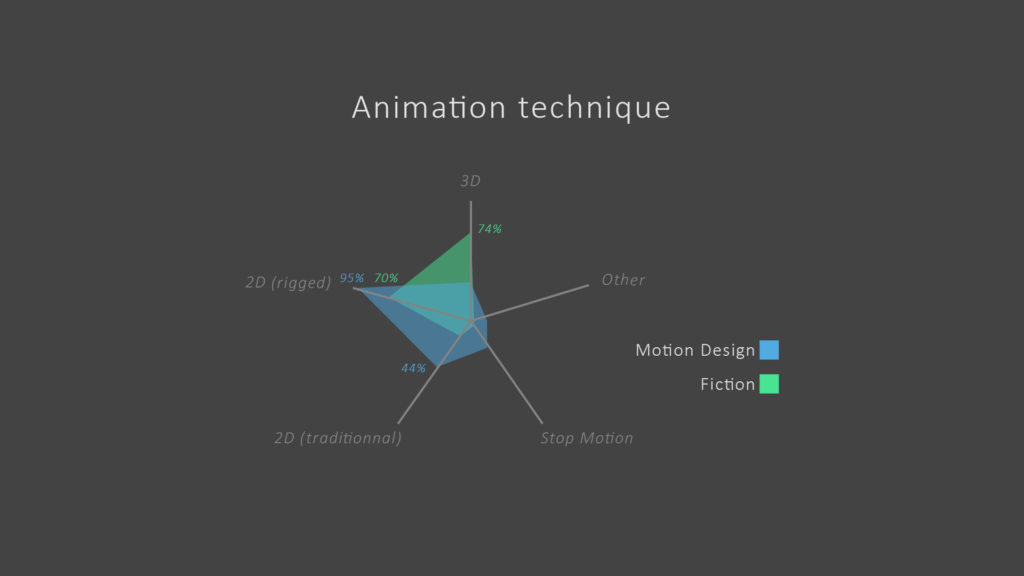
As work is organized in a very different way in fiction than in the motion design field, one can expect the tools to be very different too.
As there are a lot of software for a lot of different tasks, let’s focus on animation software.
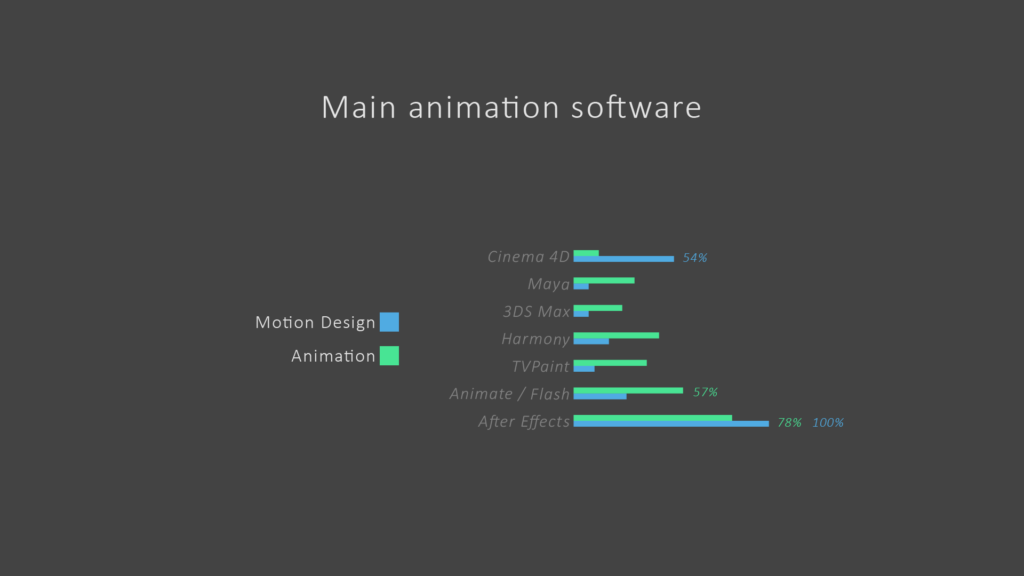
- Motion Design: 100% use After Effects, 54% use Cinema 4D
- Fiction: After Effects is used in 78% of the cases, and Flash/animate in 57%. 4 other softwares (TVPaint, Harmony, Maya, 3DS Max) are used by more than 30% of the studios, and in a noticeable way, Blender is used by 17%.
Because of the small number of answers from the fiction industry to this study, the numbers concerning the use of software cannot be accurate and may not be representative of the whole industry, but some tendencies are visible anyway.
These results are also biased because the study has been made with people not far from the Duik user community, who work with After Effects.
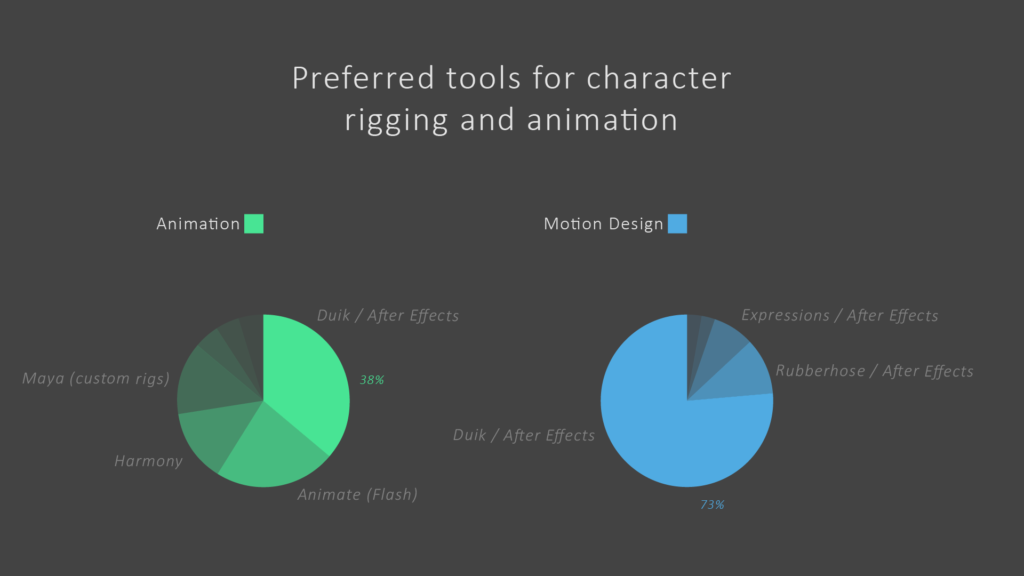
- Motion Design: More than 90% of the characters are rigged in After Effects, mainly using Duik.
- Fiction: A lot of different software are used, especially After Effects, Animate, Harmony, Maya and 3DS Max. In After Effects, a huge majority use Duik, and some others Rubberhose.
As in fiction production the teams are bigger and there’s more time to produce the films, it’s possible to have more different pipelines, involving a lot of different software, whereas in the motion design industry, people tend to all use only After Effects and Cinema 4D.
Studying the cross influence between animation and motion design.
Even if these numbers are biased, it appears that After Effects is a very important software both in the motion design industry and the animated fiction field, and Duik by far is the most common tool used to rig and animate characters in After Effects.
As the developper of Duik, this puts me in an ideal position to be in contact with both industries and to have a look at what has been done concerning character animation at the boundary between animation and motion design since Duik has been created.
In a future article, I’m going to show and write about works at the boundary between the two fields, having a look to 10 years of character animation in After Effects and how fiction and motion design influence each other.
Share your thoughts!
Do not hesitate to share your point of view about all of this in the comments, and post interesting works which could help to clarify the difference, if any, between animated fiction and motion design.
Click here to download the raw data from the study (LibreOffice *.ods).